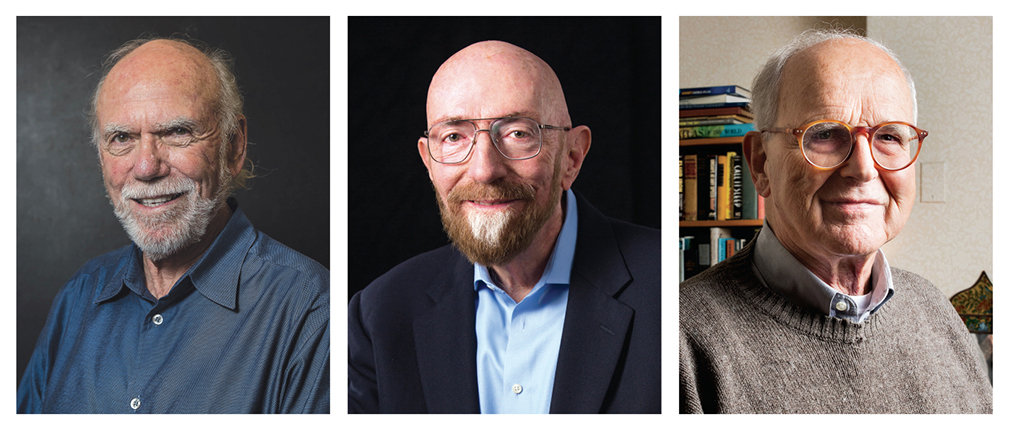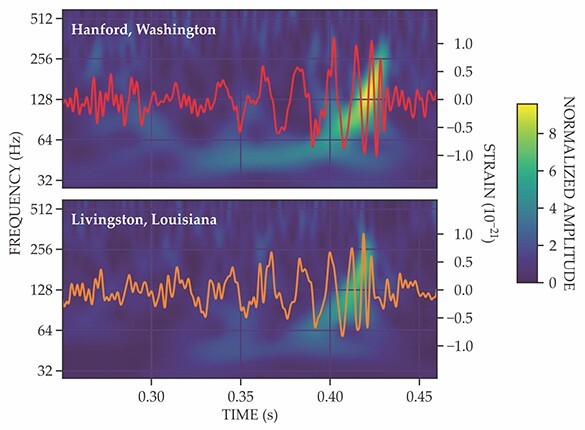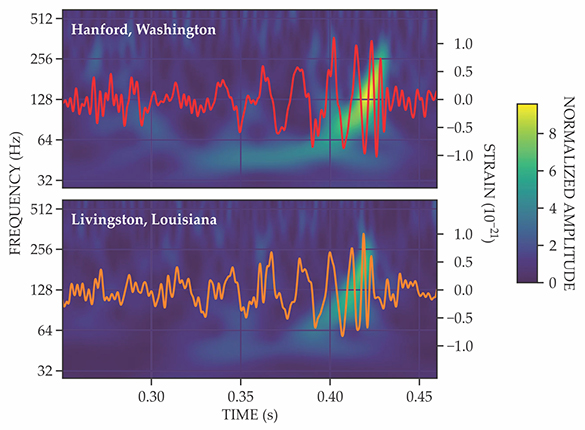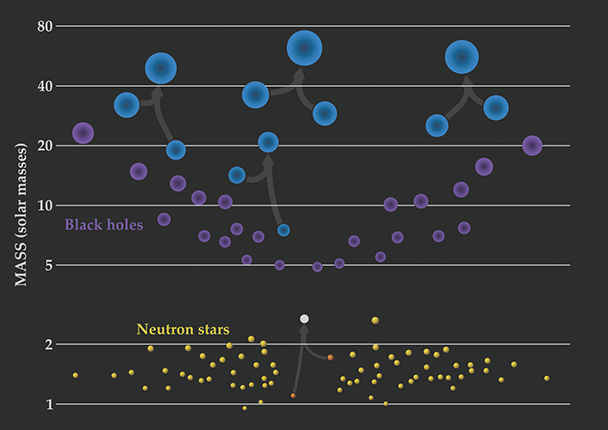Weiss, Barish, and Thorne share 2017 Nobel Prize in Physics
DOI: 10.1063/PT.3.3782
Rainer Weiss of MIT and Barry Barish and Kip Thorne of Caltech are to be awarded the 2017 Nobel Prize in Physics “for decisive contributions to the LIGO detector and the observation of gravitational waves,” the Royal Swedish Academy of Sciences announced on 3 October. Weiss will receive half the prize of 9 million Swedish krona, roughly $1.1 million; Barish and Thorne will split the other half.
Weiss and Thorne, along with the late Ronald Drever, cofounded LIGO, the Laser Interferometer Gravitational-Wave Observatory—a pair of L-shaped Michelson interferometers in Livingston, Louisiana, and Hanford, Washington. Barish became the leader of LIGO in 1994 and helped the collaboration steer through the obstacle course of planning and executing a high-risk, high-reward Big Science project.
On 14 September 2015, nearly a half century after Weiss conceived of the basic experimental design, LIGO made the first direct detection of gravitational waves, which were emitted by a pair of coalescing black holes about 1.3 billion light-years away (see Physics Today, April 2016, page 14
This is the second time the Royal Swedish Academy has awarded a physics Nobel related to gravitational waves. The 1993 prize went to Joseph Taylor and Russell Hulse, who inferred the emission of gravitational energy from the orbital decay of a binary pulsar system and the application of general relativity (see Physics Today, December 1993, page 17
The 2017 prize is not so much for confirming Albert Einstein’s century-old prediction of gravitational waves as for opening up a new field of astronomy. The detections by the LIGO–Virgo team have already informed physicists about gamma-ray bursts, gravitational-wave polarization, and stellar-mass black holes. Future discoveries by LIGO, Virgo, and their ground- and space-based successors should provide insights about cosmic evolution, supernovae, and other phenomena, some of which are largely inaccessible to traditional light-capturing telescopes.

Barry Barish, Kip Thorne, Rainer Weiss
CALTECH; CALTECH ALUMNI ASSOCIATION; M. SCOTT BRAUER

Detecting ripples in spacetime
Months after presenting his field equations in Berlin, Einstein introduced the idea of oscillations in the spacetime metric tensor in a 1916 paper. 1 All massive accelerating objects would emit such waves. Unlike electromagnetic oscillations, which are dipolar and propagate through spacetime without influencing it, gravitational waves are propagating quadrupolar perturbations of spacetime itself: They stretch space in one direction and compress it in a transverse direction. Although the amplitude of both electromagnetic and gravitational radiation is inversely proportional to distance from the source, the relative weakness of gravity makes it far harder to detect, even when the emitters are the universe’s most massive objects.
Einstein’s idea was treated as a theoretical curiosity until the 1950s, when University of Maryland physicist Joseph Weber set out to build aluminum cylinders that would resonate when a specific frequency of gravitational radiation passed through them. He claimed a detection in 1969 (see Physics Today, August 1969, page 61
Weiss devised a different approach to gravitational-wave detection in 1967, during lesson planning for a relativity course he was teaching at MIT. He envisioned light beams bouncing between mirrors in an L-shaped configuration. A passing gravitational wave would briefly alter the relative lengths of the two perpendicular paths, which would result in a potentially measurable difference in the travel time of each beam. Such a method had the potential to be far more precise than Weber’s and would enable detection of a range of gravitational-wave frequencies.
The challenges of Big Science
Weiss’s attention was partially diverted toward cofounding what would become the Cosmic Background Explorer satellite to measure the cosmic microwave background radiation, so he didn’t move forward with his interferometer idea right away. In 1972 he wrote a report about the ideal size range of such an instrument and the sources of noise—seismic, thermal, and radiation pressure among them—with which it would have to contend. 2
Meanwhile, throughout the 1970s, theoretical physicist Thorne was publishing papers 3 on the expected gravitational-wave emissions of astrophysical objects. He took notice of work by Drever, then at the University of Glasgow in Scotland, on increasing the sensitivity of gravitational-wave interferometers. Thorne persuaded Drever to come to Caltech, where he began work on a 40 m prototype detector. By the early 1980s, NSF was separately financing Drever’s interferometer and a 1.5 m prototype by Weiss at MIT. The agency soon endorsed the development of a large-scale project, LIGO, overseen by both MIT and Caltech; Congress allocated funding for construction in 1992.
The path to discovery was filled with logistical and technical challenges and personality clashes. The 1994 recruitment of Barish, who had been spearheading the construction of a detector on the recently canceled Superconducting Super Collider, proved to be a vital stabilizing event. “We absolutely would have failed without him,” says Peter Saulson of Syracuse University, who has worked on LIGO since joining Weiss at MIT as a postdoc in 1981.
Barish led the collaboration through the final design stages and convinced NSF to allocate more money to a project that was already the agency’s largest single beneficiary. He also established the LIGO Scientific Collaboration, a group of external researchers that today includes more than 1000 scientists worldwide.
The LIGO search began in 2002 with a multiyear run dedicated to demonstrating the technology—making a discovery was considered a bonus. The idea was that the lessons learned from that first phase would inform upgrades that would increase the chances for a successful detection in LIGO’s “advanced” second run.
The two detectors, located just over 3000 km apart, are essentially souped-up versions of Weiss’s original concept, with additional features invented and developed by Drever (see the article by Barish and Weiss, Physics Today, October 1999, page 44
By the time the beams recombine at the splitter, they have each traveled more than 1000 km. Assuming no disturbances, the two beams cancel each other out, leaving the experiment’s photodetector in darkness. But as a burst of gravitational waves approaches, one beam becomes slightly longer than the other; as the radiation passes across the interferometer, the other beam becomes longer. LIGO is particularly sensitive to gravitational radiation in the 20–2000 Hz range, the sweet spot for the mergers of some combination of black holes and neutron stars.
As anticipated, LIGO had not made any detections when the first phase ended in 2010. It took a five-year overhaul to get the detectors primed for success. 4 The LIGO team increased the laser power from 10 W to 200 W and executed Drever’s idea of adding a mirror to enhance the signal at particular frequencies. Engineers replaced the optical cavities’ 11 kg mirrors with 40 kg ones to lessen thermal noise and kept them immobile by suspending them from an intricate pendulum system. A vibration-isolation system continuously counteracts ambient tremors from seismic activity and the occasional 18-wheeler lumbering down a nearby road.
A resounding success
In late summer 2015, the upgraded Advanced LIGO began its engineering run. Weiss had almost shut down the Livingston detector for minor fixes on the day the chirp arrived from the merger of two black holes weighing in at 36 and 29 solar masses. The beams experienced a strain of 10–21, as shown in figure
Figure 1.

A chirp of gravitational waves from two coalescing black holes 1.3 billion light-years away was captured by the two LIGO detectors on 14 September 2015. The plot depicts strain; the background colors indicate signal amplitude at various frequencies. (Courtesy of Caltech/MIT/LIGO Laboratory.)

Since then, LIGO has added four more mergers to the catalog, as shown in figure
Figure 2.

Adding inventory.Gravitational-wave observatories are uncovering objects that are difficult to spot with traditional telescopes, including black holes (blue; the arrows indicate them merging) that are more massive than much of the previously known stellar-mass population (purple). The recently observed neutron-star merger (bottom center) will help constrain the properties of the city-sized objects (previous detections in yellow). (Courtesy of Caltech/MIT/LIGO Laboratory.)

The success of LIGO has not only spurred a new line of research but also increased support for a slate of future projects. A week after the February 2016 announcement of LIGO’s first discovery, India formally approved the construction of a detector that should be completed around 2024. LIGO-India will join KAGRA, an underground interferometer in Japan that is expected to come on line in 2019. And in June, three and a half months after Drever’s death (see the obituary on page 59
In the meantime, LIGO and Virgo are undergoing another round of improvements to increase sensitivity. When the observatories come back on line next fall, they should be able to spot the mergers of stellar-mass objects twice as distant as before, which will increase the observable volume of space—and thus the detection rate—eightfold.
References
1. A. Einstein, Sitzungsber. K. Preuss. Akad. Wiss., Jan.–June 1916, 688.
2. R. Weiss, in Quarterly Progress Report, no. 105, MIT Research Laboratory of Electronics (1972), p. 54.
3. W. H. Press, K. S. Thorne, Annu. Rev. Astron. Astrophys. 10, 335 (1972). https://doi.org/10.1146/annurev.aa.10.090172.002003
4. J. Aasi et al. (LIGO Scientific Collaboration), Class. Quantum Grav. 32, 074001 (2015).
5. B. P. Abbott et al. (LIGO Scientific Collaboration and Virgo Collaboration), Phys. Rev. Lett. 116, 061102 (2016). https://doi.org/10.1103/PhysRevLett.116.061102
More about the Authors
Andrew Grant. agrant@aip.org

